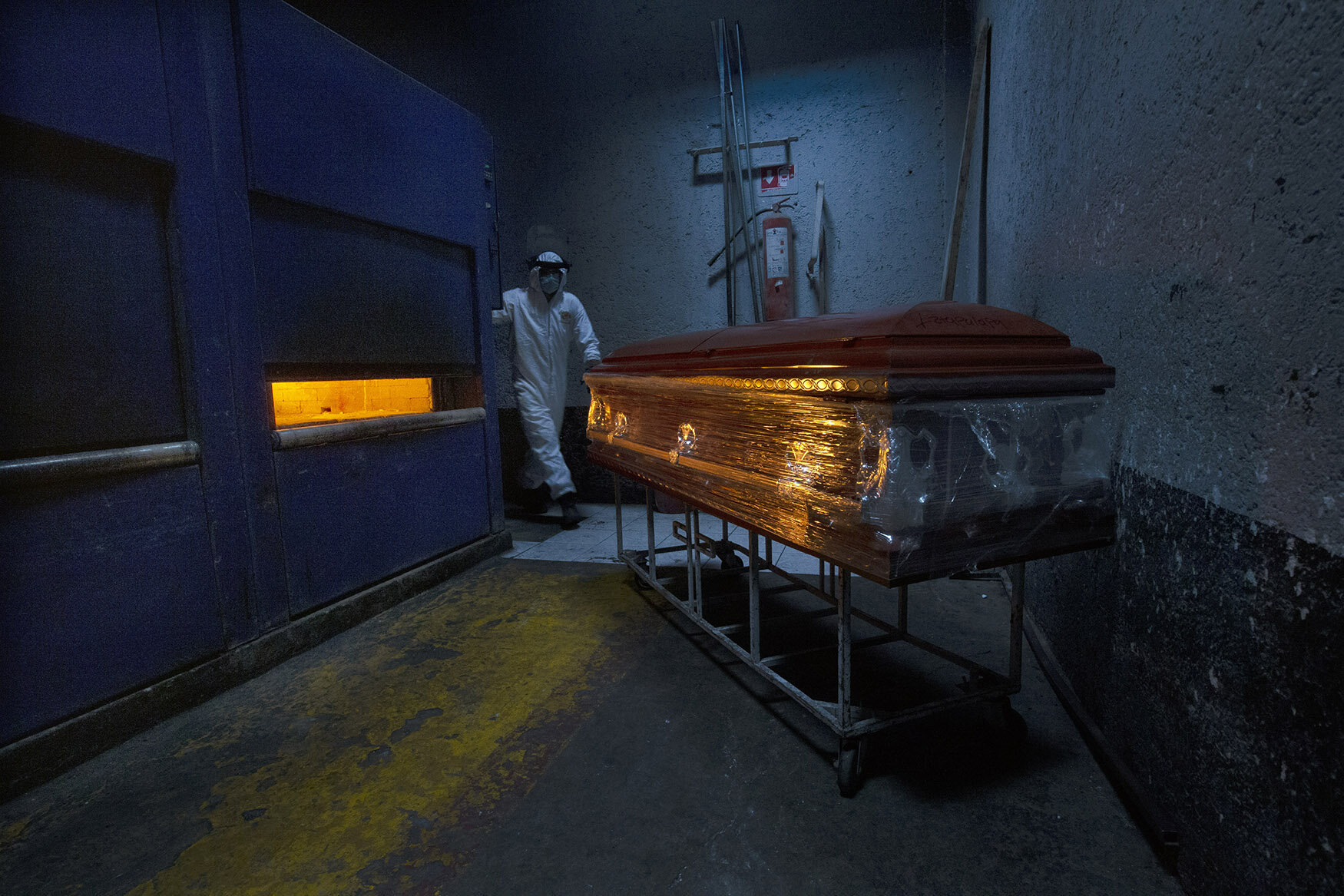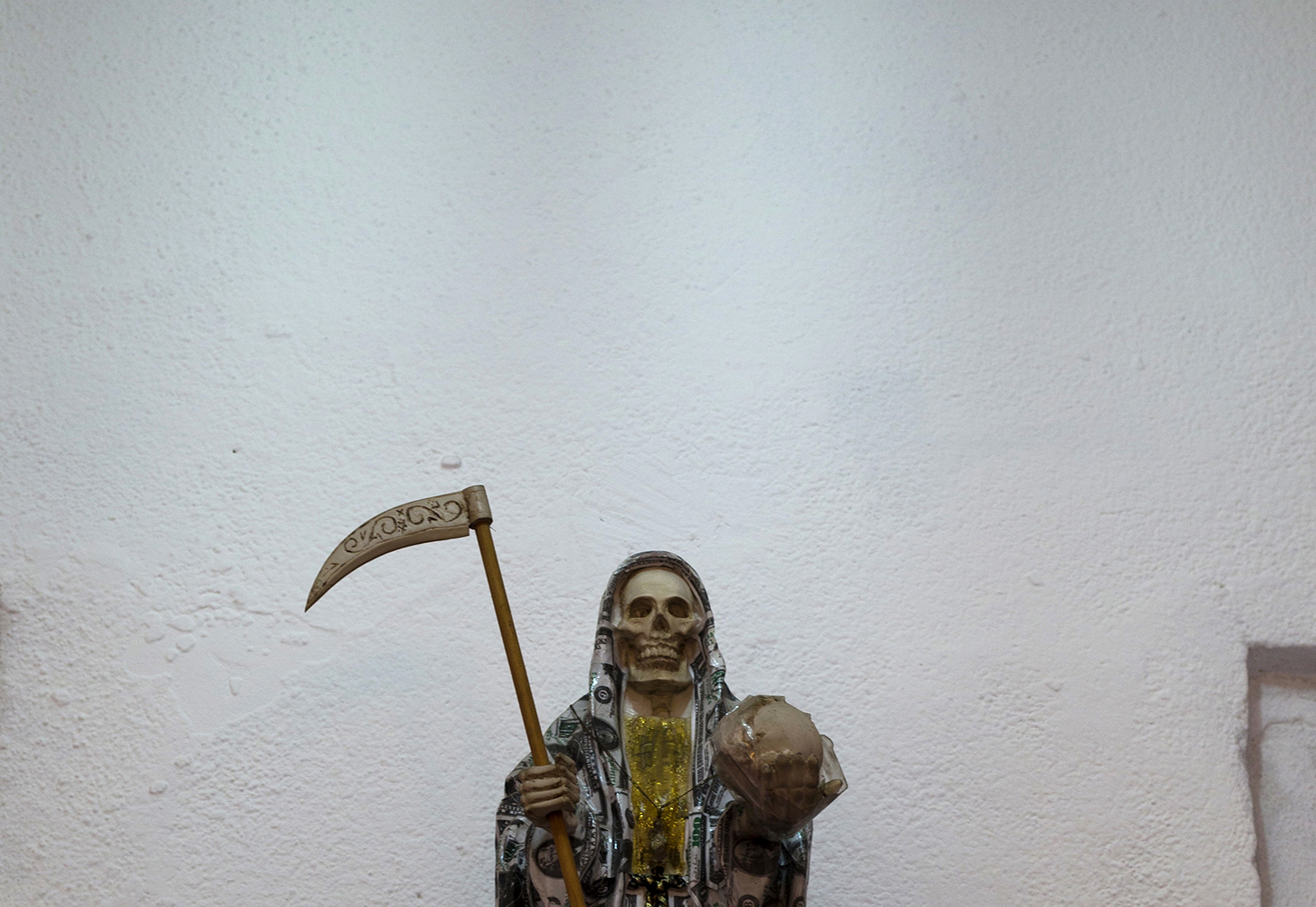Ashes, graves - pandemic's 'last link' in Mexico

Gravediggers and crematorium workers in Mexico are struggling to keep pace as the country registers escalating coronavirus death numbers while gradually easing some restrictions aimed at curbing COVID-19.
Workers at the San Lorenzo Tezonco municipal cemetery on Mexico City’s east side said in interviews with The Associated Press that they have buried more bodies in past weeks than they have ever seen before.
Antonio García said he digs 15 to 20 graves per day now and has laid to rest more than 500 coronavirus victims.
His weary colleague, Melvin Sanaurio, wiped dirt from his face.
“It takes me more than an hour to dig one grave,” Sanaurio said.
Melvin Sanaurio, front, digs a grave at the San Lorenzo Tezonco Iztapalapa cemetery in Mexico City, June 2, 2020. (AP Photo/Marco Ugarte)
Melvin Sanaurio's face is dirty after an hour of digging a grave at the San Lorenzo Tezonco Iztapalapa cemetery in Mexico City, June 2, 2020. (AP Photo/Marco Ugarte)
The work is physically and emotionally exhausting, with workers constantly in fear of becoming infected themselves. It's made worse when they have to don white plastic anti-contamination suits that seal in the heat and sweat to lower the caskets and fill in the graves.
“Between the dust and the heat, it's suffocating," García said. “We bury the coffins with the fear of catching it. We have families to protect. "
“The work of a gravedigger doesn't get much recognition,” he said. "Instead of recognition we get abuse. We are the forgotten ones, the anonymous heroes, the last link in the chain of this pandemic."
As the two talk, a hearse pulls up with another COVID-19 victim. They are easy to distinguish because the coffins are wrapped in clear plastic, and they are taken to a special area of the graveyard designated for coronavirus burials.
The workers carry the coffin there themselves, a job that in the past might have been done by mourners. But under special rules to stem the spread of the pandemic, only two relatives are allowed to accompany the coffin to the grave.
Burials are not the same anymore; now they last as little as 15 minutes.
No bands, no music, no weeping; only the strange silence, the sound of shovels hitting dry earth, which is whipped up by the wind.
A view of the Iztapalapa neighborhood of Mexico City, June 3, 2020. (AP Photo/Marco Ugarte)
About 15 minutes away, Jorge Eduardo Morales has worked for the last eight years at the San Nicolás Tolentino crematorium.
Every day, black smoke rises from the crematorium's chimney and relatives walk away with the ashes of their loved ones in small white urns.
In the first days of the pandemic in Mexico, in March, they cremated 15 bodies per day. By May, that had risen to between 30 and 35 per day.
“We are in the thick of the battle every day,” said Morales. “We may have to put on a protective shield many times when we load the bodies into the ovens, but our hearts are still exposed.”
Cemetery workers in a protective gear bury COVID-19 victims at the Panteón de San Lorenzo Tezonco Iztapalapa cemetery in a section reserved for people who died of the new coronavirus in the Iztapalapa neighborhood of Mexico City, June 2, 2020. (AP Photo/Marco Ugarte)
Jorge Eduardo Morales, left, removes the body of a COVID-19 victim to be taken to the crematorium at the Panteón San Nicolás Tolentino cemetery, in Mexico City, June 2, 2020. (AP Photo/Marco Ugarte)
Jorge Eduardo Morales leaves the Panteón San Nicolás Tolentino cemetery after an 8-hour shift at the crematorium in Mexico City, Thursday, June 4, 2020. (AP Photo/Marco Ugarte)
The government, meanwhile, is seeking a balance. It formally ended its social distancing rule and is taking other steps to reopen the economy while still urging Mexicans to maintain most of the measures designed to protect them from the new coronavirus.
As of Sunday night, Mexico had reported 13,699 COVID-19 deaths and 117,103 confirmed cases, though authorities acknowledge actual infections are far more numerous.
Arturo Morales Torres is a city employee who oversees 10 cemeteries in the eastern borough of Iztapalapa.
“In the last few months burials have increased 40% and cremations have gone up 30% because of COVID-19,” Morales said. “I have had the misfortune of receiving the bodies of people I worked with. It is very painful, to see their families crying.”
“They didn't even have time to say goodbye,” he said. “It is very sad, they are our friends and it hurts, but we have to bury them.”
Cemetery coordinator Arturo Morales Torres talks on his cell phone past a mural of a skeleton and bones that decorate the exterior of the Panteón San Nicolás Tolentino de Iztapalapa cemetery in Mexico City, June 4, 2020. (AP Photo/Marco Ugarte)
A body burns inside the oven of the crematorium inside the Panteón de San Nicolás Tolentino cemetery in the Iztapalapa neighborhood of Mexico City, Wednesday, June 3, 2020. (AP Photo/Marco Ugarte)
People look at the coffin of a family member who died of COVID-19 before it is lowered into a grave site, in a section for victims of the new coronavirus, in the Iztapalapa neighborhood of Mexico City, June 2, 2020. (AP Photo/Marco Ugarte)
A street dog sleeps amid the tombs at the San Nicolas Tolentino Pantheon cemetery as workers makes space for more burials amid the COVID-19 pandemic in the Iztapalapa neighborhood of Mexico City, May 27, 2020. (AP Photo/Marco Ugarte)
A funeral service worker sprays a bodybag containing remains before it is removed and taken to the crematorium at the Panteón San Nicolás Tolentino cemetery in the Iztapalapa neighborhood of Mexico City, June 2, 2020. (AP Photo/Marco Ugarte)
Cemetery workers in a protective gear shovel dirt over the gravesite of a COVID-19 victim at the Panteón de San Lorenzo Tezonco Iztapalapa cemetery, in a section for victims of the new coronavirus, in the Iztapalapa neighborhood of Mexico City, June 2, 2020. (AP Photo/Marco Ugarte)
Smoke rises from the crematorium at the Panteón de San Nicolas Tolentino cemetery in the Iztapalapa neighborhood of Mexico City, June 2, 2020. (AP Photo/Marco Ugarte)
Hearse drivers transporting the bodies of COVID-19 victims arrive at the crematorium at the Panteón San Nicolás Tolentino cemetery in the Iztapalapa neighborhood of Mexico City, June 2, 2020. (AP Photo/Marco Ugarte)
A man holding an urn watches the body of a family member who died of COVID-19 get taken to the crematorium by workers at the Panteón San Nicolás Tolentino cemetery in the Iztapalapa neighborhood of Mexico City, June 2, 2020. (AP Photo/Marco Ugarte)
A sign marks the gravesite of Juan Pepe Martinez Ramirez, who was born on Dec. 1, 1978 and died on May 21, 2020, in a section of the San Lorenzo Tezonco Iztapalapa cemetery reserved for COVID-19 victims in the Iztapalap neighborhood of Mexico City, June 2, 2020. (AP Photo/Marco Ugarte)
Clutching a cigarette, a man holds an urn for human ashes as he watches the body of a family member, who died of COVID-19, as it is taken inside the crematorium by workers at the Panteón San Nicolás Tolentino cemetery in Iztapalapa, Mexico City, June 2, 2020. (AP Photo/Marco Ugarte)
Workers in protective gear amid the new coronavirus pandemic remove a coffin after placing the body into the oven at the crematorium inside the Panteón San Nicolás Tolentino cemetery in Iztapalapa, in Mexico City, June 4, 2020. (AP Photo/Marco Ugarte)
Cemetery workers in a protective gear lower a coffin wrapped in plastic, containing a COVID-19 victim, into a gravesite at the San Lorenzo Tezonco Iztapalapa cemetery in Mexico City, June 2, 2020. (AP Photo/Marco Ugarte)
Cemetery musician Victor Dzib Cima plays his accordion as he waits for clients while cemetery workers remove coffins from gravesites that belonged to families who stopped paying rent in the Iztapalapa area of Mexico City, May 22, 2020. (AP Photo/Marco Ugarte)
Empty and charred coffins lay outside the crematorium in the San Nicolás Tolentino Pantheon cemetery in the Iztapalapa neighborhood of Mexico City, May 27, 2020. (AP Photo/Marco Ugarte)
Text from AP News story, AP PHOTOS: Ashes, graves -- pandemic's 'last link' in Mexico, by Marco Ugarte.





